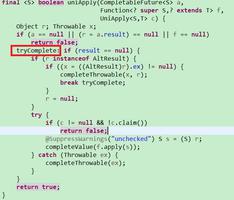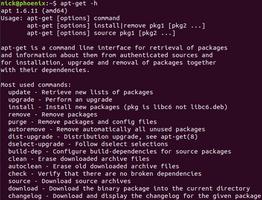对Future.get()块的方法调用。这真的可取吗?
在将此问题标记为重复之前,请仔细阅读问题。
以下是伪代码的代码段。我的问题是-下面的代码是否不会破坏并行异步处理的概念?
我之所以这样问,是因为在下面的代码中,主线程会提交要在其他线程中执行的任务。在队列中提交任务后,它将阻塞Future.get()方法,以使任务返回值。我宁愿在主线程中执行任务,而不是提交到其他线程并等待结果。通过在新线程中执行任务可以得到什么?
我知道您可以等待有限的时间等,但是如果我真的在乎结果怎么办?如果要执行多个任务,问题将变得更加严重。在我看来,我们只是同步进行工作。我知道Guava库提供了一个非阻塞侦听器接口。但是我很想知道我对Future.get()API的理解是否正确。如果是正确的,为什么将Future.get()设计为阻塞从而破坏了并行处理的整个过程?
注意-为了进行记录,我使用JAVA 6
public static void main(String[] args){private ExectorService executorService = ...
Future future = executorService.submit(new Callable(){
public Object call() throws Exception {
System.out.println("Asynchronous Callable");
return "Callable Result";
}
});
System.out.println("future.get() = " + future.get());
}
回答:
Future为您提供isDone()不阻塞的方法,如果计算完成,则返回true,否则返回false。
Future.get() 用于检索计算结果。
您有两种选择:
- 调用
isDone(),如果结果准备就绪,可以通过调用来请求get(),请注意没有阻塞 - 无限期封锁
get() - 指定超时时间
get(long timeout, TimeUnit unit)
整个Future API过程有一种简单的方法可以从执行并行任务的线程中获取值。如上面的项目符号所述,可以根据需要同步或异步完成此操作。
这是 Java Concurrency In Practice中的 一个缓存实现,是一个非常好的用例Future。
- 如果计算已经在运行,则对计算结果感兴趣的调用方将等待计算完成
- 如果结果已在缓存中准备好,则调用者将收集它
- 如果结果尚未准备好并且尚未开始计算,则调用方将开始计算并将结果包装在
Future其他调用方中。
使用FutureAPI 可以轻松实现所有目标。
package net.jcip.examples;import java.util.concurrent.*;
/**
* Memoizer
* <p/>
* Final implementation of Memoizer
*
* @author Brian Goetz and Tim Peierls
*/
public class Memoizer <A, V> implements Computable<A, V> {
private final ConcurrentMap<A, Future<V>> cache
= new ConcurrentHashMap<A, Future<V>>();
private final Computable<A, V> c;
public Memoizer(Computable<A, V> c) {
this.c = c;
}
public V compute(final A arg) throws InterruptedException {
while (true) {
Future<V> f = cache.get(arg);
// computation not started
if (f == null) {
Callable<V> eval = new Callable<V>() {
public V call() throws InterruptedException {
return c.compute(arg);
}
};
FutureTask<V> ft = new FutureTask<V>(eval);
f = cache.putIfAbsent(arg, ft);
// start computation if it's not started in the meantime
if (f == null) {
f = ft;
ft.run();
}
}
// get result if ready, otherwise block and wait
try {
return f.get();
} catch (CancellationException e) {
cache.remove(arg, f);
} catch (ExecutionException e) {
throw LaunderThrowable.launderThrowable(e.getCause());
}
}
}
}
以上是 对Future.get()块的方法调用。这真的可取吗? 的全部内容, 来源链接: utcz.com/qa/435887.html




